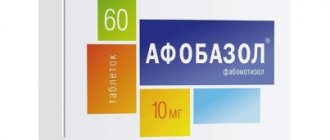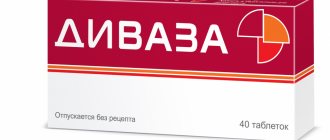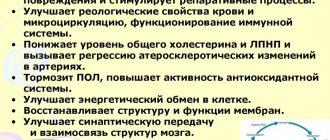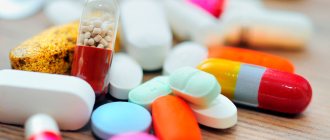Pharmacodynamics
Eltacin® is a combination drug that contains a mixture of non-essential amino acids: glycine, glutamic acid and cystine, which are metabolic regulators: increasing the intracellular concentration of glutathione and the activity of glutathione-dependent enzymes, normalizing redox processes and oxygen utilization in tissues, due to which the drug:
— exhibits antioxidant (reduces the content of free radicals, peroxide compounds, malondialdehyde) and antihypoxic (increases the body’s resistance to oxygen deficiency, enhancing the processes of ATP synthesis) effect;
— increases myocardial contractility;
- increases physical performance;
— improves the quality of life of patients with chronic heart failure (increases social adaptation, improving psycho-emotional state);
— accelerates the recovery of performance after intense physical activity in children.
Instructions
Composition/description
Registration number: LS-000499
Trade name: Eltacin®
Group name:
Glycine + Glutamic acid + Cystine.
Dosage form:
sublingual tablets.
Composition (per tablet):
active ingredients: glycine – 70 mg, glutamic acid – 70 mg, cystine – 70 mg; excipients: methylcellulose – 7.8 mg, magnesium stearate – 2.2 mg.
Description:
round biconvex tablets of white or white with a yellowish tint.
Pharmacotherapeutic group:
antioxidant agent.
ATX code:
C01EX.
Pharmacological properties
Pharmacodynamics:
Eltacin® is a combination drug that contains a mixture of non-essential amino acids: glycine, glutamic acid and cystine. The components of Eltacin® are metabolic regulators that increase the intracellular concentration of glutathione and the activity of glutathione-dependent enzymes, normalizing redox processes and oxygen utilization in tissues, due to which the drug:
- exhibits antioxidant (reducing the content of free radicals, peroxide compounds, malondialdehyde) and antihypoxic effects (increasing the body's resistance to oxygen deficiency, enhancing the synthesis of adenosine triphosphoric acid (ATP));
- increases myocardial contractility;
- increases physical performance;
- improves the quality of life of patients with chronic heart failure (increasing social adaptation, improving psycho-emotional state);
- accelerates recovery of performance after intense physical activity in children.
Pharmacokinetics:
glycine penetrates into most biological fluids and tissues of the body, incl. into the brain, does not accumulate in tissues, is metabolized to water and carbon dioxide. When taken, glutamic acid is well absorbed and penetrates the blood-brain barrier and cell membranes. It is utilized during metabolism, 4–7% is excreted unchanged by the kidneys. After administration, the concentration of cystine gradually increases, reaching a maximum after 30 minutes, and then slowly decreases. Cystine does not accumulate and is not toxic.
Indications for use
Autonomic dysfunction syndrome in adults and children over 12 years of age.
Prevention of chronic physical overstrain and recovery after intense physical activity during sports in children aged 11 to 15 years.
Chronic heart failure of functional class I–III according to the NYHA classification in adults (against the background of standard therapy).
Chronic heart failure of functional class I–II according to the NYHA classification in children over the age of 12 years (against the background of standard therapy).
Contraindications:
hypersensitivity to the drug, children under 11 years of age (efficacy and safety have not been established).
Precautions for use:
does not require special precautions.
Use during pregnancy and breastfeeding:
No separate studies have been conducted. Not recommended for use during pregnancy and breastfeeding.
Directions for use and doses
Sublingually. The tablet can also be chewed and held in the mouth under the tongue until completely dissolved.
Autonomic dysfunction syndrome in adults and children over 12 years of age: 1 tablet 3 times a day sublingually, course of treatment from 1 to 3 months depending on the severity of the disease, repeated courses are prescribed on the recommendation of a doctor.
Prevention of chronic physical overexertion in children aged 11 to 15 years: 1 tablet 2 times a day for 2–3 weeks.
During the recovery period after intense physical activity when playing sports in children aged 11 to 15 years: 1 tablet 3 times a day for 2 weeks.
Chronic heart failure of functional class I–III according to the NYHA classification in adults: 1 tablet 3 times a day sublingually, course of treatment from 1 to 3 months depending on the severity of the disease, repeated courses are prescribed on the recommendation of a doctor.
Chronic heart failure of functional class I–II according to the NYHA classification in children over 12 years of age: 1 tablet 3 times a day sublingually, course of treatment from 1 to 3 months depending on the severity of the disease, repeated courses are prescribed on the recommendation of a doctor.
Additional Information
Side effect.
Allergic reactions are possible.
Overdose.
No cases of overdose have been identified.
Interaction with other drugs.
Can be taken simultaneously with angiotensin-converting enzyme (ACE) inhibitors, beta-blockers, diuretics, aldosterone antagonists, organic nitrates and slow calcium channel blockers.
The possibility of the drug influencing the ability to drive vehicles and other potentially dangerous mechanisms:
does not affect.
Release form.
Sublingual tablets, 70 mg+70 mg+70 mg. 30 tablets in a blister pack made of polyvinyl chloride film and aluminum foil. 1 blister pack along with instructions for use in a cardboard pack.
Storage conditions:
at a temperature not exceeding 25 °C in the original packaging (blister packaging in a pack). Keep out of the reach of children.
Best before date.
3 years. Do not use after the expiration date indicated on the package.
Vacation conditions.
Available without a prescription.
Indications for the drug Eltacin®
chronic heart failure of functional class I–III according to the NYHA classification in adults (against the background of standard therapy);
chronic heart failure of functional class I–II according to the NYHA classification in children aged 12 to 18 years (against the background of standard therapy);
autonomic dysfunction syndrome in children aged 12 to 18 years;
prevention of chronic physical overstrain and recovery after intense physical activity when playing sports in children aged 11 to 15 years.
Eltacin®: description of the drug
Eltacin® is a combination drug that acts as an antioxidant and antihypoxant (i.e., it improves the excretion of oxygen and increases the body's resistance to oxygen deficiency). It contains three active components: glycine, cysteine and glutamate. This unique combination of amino acids has a triple effect: it regulates metabolism, increases the stability of the central nervous system, and provides maximum protection for the cardiovascular system.
Amino acid glycine
is a regulator of metabolism and a stabilizer of mental processes. Thanks to it, metabolic reactions in brain tissue are accelerated and psycho-emotional stress is reduced.
Cysteine
, which is part of Eltacin®, is necessary to maintain optimal glutamate concentrations and normal functioning of muscle tissue. By activating metabolic and recovery processes, it increases resistance to stress and infections, accelerates the elimination of toxic products and fills the body with additional energy.
Glutamate (glutamic acid)
is the main “fuel” for the brain. This organic compound prevents the development of oxygen starvation, binds and removes ammonia from the body, takes part in the synthesis of ATP and the transfer of potassium ions.
The 3 active components that make up Eltacin® form the tripeptide glutathione. This is the most powerful antioxidant known today, acting directly on the cause of vegetative-vascular dystonia.
Directions for use and doses
Sublingual. The tablet can also be chewed and held in the mouth under the tongue until completely dissolved.
CHF I–III functional class according to the NYHA classification in adults; CHF functional class I–II according to the NYHA classification in children aged 12 to 18 years; autonomic dysfunction syndrome in children aged 12 to 18 years: 1 table. 3 times a day, the course of treatment is from 1 to 3 months, depending on the severity of the disease, repeated courses are prescribed on the recommendation of a doctor.
Prevention of chronic physical overexertion in children aged 11 to 15 years: 1 table. 2 times a day for 2–3 weeks.
During the recovery period after intense physical activity when playing sports, children aged 11 to 15 years - 1 table. 3 times a day for 2 weeks.
Pharmacological properties
The drug Eltacin® has the following effects:
- reduces the concentration of oxidation products;
- prevents the development of oxygen starvation;
- increases physical and mental activity;
- improves nutrition of the heart muscle;
- normalizes the psycho-emotional background;
- improves the condition of the autonomic nervous system;
- reduces feelings of anxiety and aggression;
- restores the level of social adaptation;
- reduces the toxic effect of substances that disrupt the functioning of the central nervous system.
Indications for use
In accordance with the instructions for use, Eltacin® is approved for use in the following situations:
- in case of disruption of the autonomic nervous system in adults and children over 12 years of age;
- with prolonged stress, psycho-emotional stress;
- nervous disorders (emotional instability, consequences of traumatic brain injuries, neurogenic infections, sleep disorders, increased nervous excitability);
- chronic physical / mental exhaustion in children 12–15 years old.
How to take Eltacin® in the treatment of vegetative-vascular dystonia
Eltacin®, part of the group of over-the-counter drugs, is available in the form of lozenges. According to the indications for use, this drug is allowed to be used in the treatment of vegetative-vascular dystonia.
For adults with VSD, Eltacin® is recommended to take 1 tablet 3 times a day, for children - 1 tablet 2 times a day, regardless of meals. How long the course of treatment will last is determined by the attending physician. In accordance with the instructions, the duration of the course is 1–3 months for adults and 2–3 weeks for children.
Taking Eltacin® is contraindicated for patients under 12 years of age and for people with individual intolerance to the components of the drug.
To date, Eltacin® is recognized as the only specialized drug with general action that can combat the manifestations of VSD.
In what situations will Eltacin® be useful to you?
The main indications for use of the drug are autonomic dysfunction. Eltacin® is also recommended for increased physical activity to avoid complications for the cardiovascular system, including for professional athletes, as well as for heart failure as part of complex treatment.
The quality of life of people with chronic heart failure is determined by how rationally they can distribute their own physical resources. Eltacin® improves the contractility of the myocardium and reduces its need for oxygen, so even with ineffective blood circulation, heart cells do not suffer from a lack of energy. Regular use of Eltacin® prolongs active life in chronic heart failure, reduces the severity of symptoms, and in acute heart failure improves the prognosis and helps to recover faster. Used as a cardioprotector.
If you decide to lose weight in the gym or go jogging, but are not confident in your physical endurance, start a course of Eltacin® 2 weeks before training. This will protect your heart from unnecessary stress and prevent all possible complications that you risk getting before you begin to get into the desired shape.






